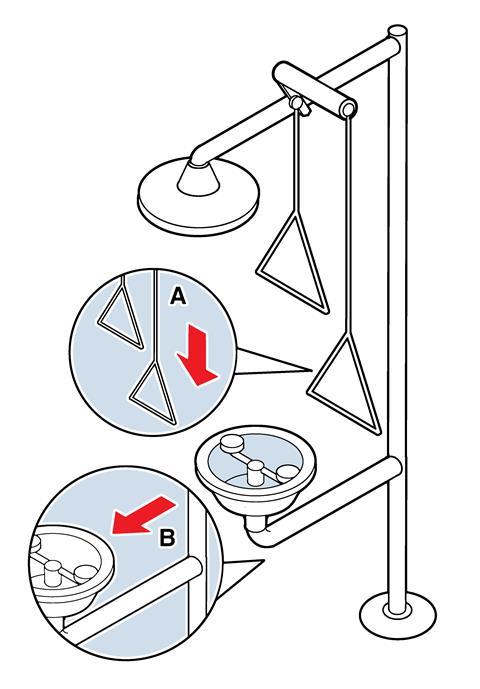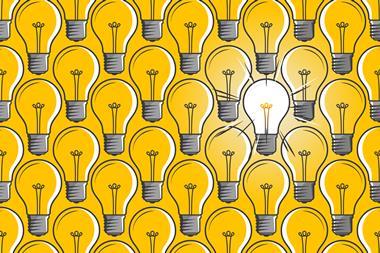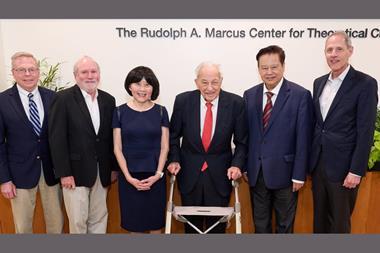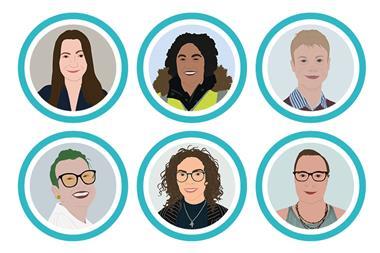Making buildings accessible for everyone
For many people, lab spaces are not the comfortable and serviceable working environment they should be. Around 22% of the UK population has a disability but disabled people remain massively underrepresented across the scientific sector, with less than 4% of academic staff declaring a disability. With such a stark disparity between these figures, it’s clear there’s a systemic problem in science.
The introduction of the Equality Act in 2010 has improved the working landscape for disabled people, providing protection against discrimination and a right to reasonable adjustments in the workplace. Declared disabilities doubled in science between 2008 and 2019 but nonetheless remain significantly and consistently lower than in other sectors, with numbers falling rapidly with increasing responsibility.
‘The simple Equality Act definition of disability is any difference that has a significant impact on your day-to-day activities and lasts more than six months,’ explains Emrys Travis, a disability and accessibility specialist at the Royal Society of Chemistry. ‘But it’s more helpful to use the social model: disability is a disenfranchisement that arises through interaction with a traditionally ableist society. So we could talk about enabling versus disabling environments, for example.’
What is disability?
Disability is an umbrella term, referring to any long-term condition or impairment that has a significant impact on your day-to-day activities. This definition covers a huge range of lived experiences which may be permanent, temporary (although lasting more than six months), recurrent or fluctuating. Disability can take many forms and often people are unaware that their particular experiences count. Some of the most common types of disability are:
- Mobility impairments – any physical disability that affects movement and dexterity. Includes amputation, paralysis, muscular dystrophy, cerebral palsy
- Sensory impairment – the loss or impairment of distance senses (sight and hearing). Includes deafness, blindless, visual impairment, hearing impairment
- Neurodiversity – any condition which affects the way an individual processes information. Includes autism, ADHD, Tourette Syndrome, dyslexia
- Mental health – any condition which affects an individual’s mood, thinking, or behaviour. Includes anxiety, depression, schizophrenia, dementia
- Chronic illness – any long lasting disease or health condition. Includes cancer, epilepsy, arthritis, irritable bowel syndrome
This is not an exhaustive list.
Despite the legal protections provided by the Equality Act, physical and social barriers still remain that prevent disabled individuals from fully participating in the scientific community. The vague term ‘reasonable adjustments’ is subject to interpretation by employers but a poor understanding of many conditions means accommodations often fail to meet the specific needs of the individual. ‘We need spaces that can be accessed on an equal basis,’ says Travis. ‘Enabling environments that allow everyone to not just get in the door but participate equally: physically, intellectually and socially, regardless of their disability status.’
Clearly, much more must be done to increase the inclusivity of the scientific community, starting with the way we design our workspaces.
Immersed in accessibility

Taking on this accessible design challenge, Brad Duerstock from Purdue University, US, launched a $2 million (£1.7 million) renovation project in 2010, funded by the National Institutes of Health Director’s Pathfinder Award, to address the physical challenges of practical work. The result was the Accessible Biomedical Immersion Lab (ABIL).
‘A lot of the inspiration stemmed from my own personal struggles with trying to do biomedical research,’ explains Duerstock, who uses a motorised wheelchair. ‘Previously I had faced these technical hurdles that I couldn’t accomplish, but then we started looking at the external factors and what things we could do to improve that environment. The focus of the ABIL project was really to allow disabled researchers functional independence.’
Wheelchair users face a number of challenges in conventional labs: the cramped spaces often restrict manoeuvrability, and the high surfaces and lack of leg room limit access to key workstations. The reconfigured floor plan in ABIL created an accessible work triangle, specifically designed with wheelchair access in mind. A power-adjustable workbench enables researchers to adapt the height to suit their working style, while the reduced-height fumehood, complete with cut-out leg room, allows seated researchers to comfortably and safely perform experiments. The taps for the adjacent lowered sink were switched to an easy-to-use paddle design and positioned at the front of the unit for the convenience of seated researchers. ‘This design had a lot to do with human factors and the ergonomics of using these spaces,’ says Duerstock. ‘Adjustable height furniture can accommodate someone who uses a wheelchair, someone using a stool or someone standing, so these types of things are of great value to everyone.’
The team was keen to ensure that this new space would cater for all researchers and sought advice from across the faculty to understand the varied needs of staff and students with different experiences of disability. The final design incorporated several sensory features including Braille, voice-activated and talking equipment, screens and floor signs to support those with visual or audio impairments.

Duerstock and colleagues Phillip Dunston and George Takahashi also created a virtual tour and 3D simulation of the space. The interactive simulation allows users to view the lab from various perspectives including standing, seated and low vision, enabling researchers to determine the potential physical challenges and arrange appropriate support before starting work. ‘With every disability, there are a unique set of challenges,’ comments Duerstock. ‘A potential researcher won’t necessarily have all the answers so part of the ABIL process was to understand those issues and prepare for those researchers before they start.’
Assistive technology continues to be a key focus of Duerstock’s research and he remains passionate about challenging the perceived limitations of disabled scientists. ‘I think a lot of people think of diversity as more of a social good,’ he comments. ‘But in reality, people with disabilities have a lot of lived experiences that can really push science forward.’
Designing for neurodiversity
Poor general understanding of many invisible disabilities can create a culture where individuals feel they must suffer in silence. At the University of Bristol, UK, a project led by Asha Sahni, chair of the Neurodiversity Staff Network, aims to raise awareness of neurodivergent conditions and address aspects of university practise that could better meet the needs of the neurodiverse community. ‘These conditions affect the way that people process different types of information,’ explains Pete Quinn, an inclusion consultant working on the project. ‘For example, that could be someone’s ability to process written information versus verbal, a heightened awareness of particular smells or sounds, or their perception of time and space.’ These alternative or enhanced perceptual experiences can make environments such as cafeterias and lecture halls particularly overwhelming, causing unintended discomfort or stress to neurodivergent individuals. In many cases, these supporting areas of research buildings are where real scientific discussion happens but the many challenges associated with such shared spaces can prevent some researchers from engaging fully.
Modifications could be as simple as moving the furniture
To showcase some of these challenges, the team evaluated the university’s engineering building, assessing the good and bad design features from neurodivergent perspectives. Four key elements emerged from this analysis: visual factors, audio factors, information access and shared spaces. ‘People may experience sensitivity to light, colour schemes or patterns, to particular sounds or loud spaces, so we were looking at background noise, electronic hums, light levels and whether they can be adjusted,’ says Quinn. ‘This kind of adjustability enables people to just be comfortable in a particular space, and there are very few people who wouldn’t benefit from that.’ Modifications could be as simple as installing a dimmer switch or moving the furniture.
Quinn also emphasises the value of clear signage, not simply as a navigational tool but as a useful visual cue to help visitors better interact with the building. Information about how to book rooms, who to contact for certain inquiries, and building rules and expectations all contribute to a feeling of confidence and comfort in the workplace. ‘Throughout the whole University of Bristol library spaces [across different departments] it is really clear what is expected in each space,’ says Quinn. ‘There are quiet spaces, happy-to-chat spaces and there are silent spaces. That’s really helpful for people with an autistic profile in particular because it gives them the norm of what is expected in those spaces.’
Sahni and the Neurodiversity Staff Network are working to expand the project across the university and hope that by improving understanding of what neurodiversity means, they can put more support in place. ‘Neurodiverse people are fairly well represented in science. Whether they are enabled to be as successful as they might is another matter,’ comments Quinn. ‘I think one key thing is to change the culture and perception of neurodiversity in university departments and I think the research councils could do much more to support this.’
Getting support
With disability awareness increasing all the time, more support than ever is available to help disabled scientists feel at home in the lab. In the UK, government initiatives such as the Disabled Students’ Allowance and the Access to Work scheme provide funding to enable universities and employers to make practical and impactful adjustments, and most academic institutions have a dedicated disability service. These support teams evaluate an individual’s specific needs, implementing the necessary practical adjustments and acting as a point of advice for staff and students.
Other initiatives such as the Enable Science Network offer a platform for disabled researchers to share their knowledge and experiences, providing helpful resources and advocating for the needs of disabled scientists. The sense of community created by these networks is invaluable, particularly for those who have formerly felt isolated by their experience of disability. ‘Peer support, mentors and role models are really important,’ says Travis. ‘A lot of people have impostor syndrome over asking for adjustments or aren’t aware of the support that is available.’
Don’t settle for crumbs!
The Royal Society of Chemistry is dedicated to inclusion and diversity and offers varied and extensive support for its members. ‘The careers advice service is a great resource and the advisers are experts in disability issues, job seeking and accessing reasonable adjustments in the workplace,’ says Travis. ‘There’s financial support too: the accessibility grant supports members attending chemistry-related professional development events by covering additional disability-related costs, and the Chemists’ Community Fund provides general support to members struggling with anything that impacts their chemistry career.’
While many problems still remain in the scientific community, small positive projects are raising awareness and changing perceptions of disability, slowly breaking down the barriers faced by disabled scientists. ‘We want to stir up these sorts of widespread changes,’ says Travis. ‘Don’t settle for crumbs! Ask for everything you need and back yourself. You have the right to thrive as much as anybody.’












No comments yet